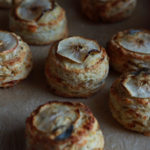
Apple, Sage, and Gruyère Scones
A seriously flaky, sweet and savory buttermik scone. Feel free to add more cheese if you want to up the decadence. This recipe is very loosely based on one of the buttermilk scone recipes in The Best Quick Breads, by Beth Hensperger, one of my best impulse-purchased cookbooks.
Ingredients
- 380 g all-purpose flour
- 2 tbsp sugar
- 1 tbsp baking powder
- 1/2 tsp baking soda
- 1/2 tsp table salt or fine sea salt
- 1/4 tsp freshly ground black pepper or to taste (optional)
- 140 g (10 tbsp) cold unsalted butter cut into chunks
- 70 g Gruyere cheese coarsely grated
- 1 tbsp chopped fresh sage
- 1 cup cold buttermilk
- 2 smallish crisp apples peeled, cored, and cut into 1/2 inch dice
To finish:
- buttermilk, heavy cream, and/or a lightly beaten egg
- thin slices of apple and/or small sage leaves
- 1/2 tsp sugar
Instructions
-
Preheat the oven to 400 F.
-
Spread the diced apple on a parchment-lined baking sheet and bake for 10-15 minutes, until the apple pieces are dry to the touch. Remove from the oven and allow to cool completely.
-
In a large bowl, whisk together the flour, 2 tablespoons sugar, baking powder, baking soda, salt, and optional black pepper. Transfer the bowl to the freezer to chill for about 5 minutes.
-
Remove the chilled flour mixture from the freezer and add the butter chunks. Use a pastry blender to cut in the butter until it is well distributed and the largest pieces are the size of peas. Mix in the chopped sage and half the shredded cheese.
-
Make a well in the center of the flour mixture and add the buttermilk. Use a wooden spoon or silicone spatula to mix together the flour mixture and buttermilk, switching to your hands as the mixture starts to come together into a dough. Once the mixture has mostly come together (there can be some lingering stray dry bits of flour), turn it out onto a lightly floured surface and gently knead it together into a cohesive dough.
-
Using a lightly floured rolling pin, roll the dough out into a rectangle about 9 by 12 inches in size. Spread the roasted apple chunks over the dough, then sprinkle with the remaining shredded cheese, pressing down gently on the apples and cheese to help them adhere.
-
Fold the dough into thirds, like a business letter, to encase the apples and cheese. (If the dough is sticking at all to the work surface, use a bench scraper to help ease it off.) After completing the business letter fold, turn the now smaller rectangle of dough 90 degrees, then roll it out into a larger rectangle about 6 by 12 inches in size and approximately 3/4 inch thick.
-
Use a bench scraper to transfer the dough to a parchment lined baking sheet, transfer the sheet to the freezer, and freeze for 30 minutes.
-
Increase the oven temperature to 450 F.
-
Remove the dough from the freezer and transfer it to a work surface. Use a lightly floured 2.5-inch or 3-inch biscuit cutter to cut out 8 scones. (Press straight down without twisting.) Gather the scraps together, roll them out again, and cut out the two last scones. Place the scones back on the baking sheet, and brush the tops with some buttermilk, heavy cream, lightly beaten egg, or a mixture of egg and cream or buttermilk. Place a thin slice of apple and/or a couple of sage leaves on top of each scone, and return the scones to the freezer for 5 minutes.
-
Remove the unbaked scones from the freezer, transfer them to a fresh parchment-lined baking sheet, and sprinkle the tops of the scones with granulated sugar.
-
Place the scones in the oven and immediately reduce the oven temperature to 425 F.
-
Bake the scones for 22-25 minutes, until the edges are golden brown.
-
The scones are best eaten fresh!